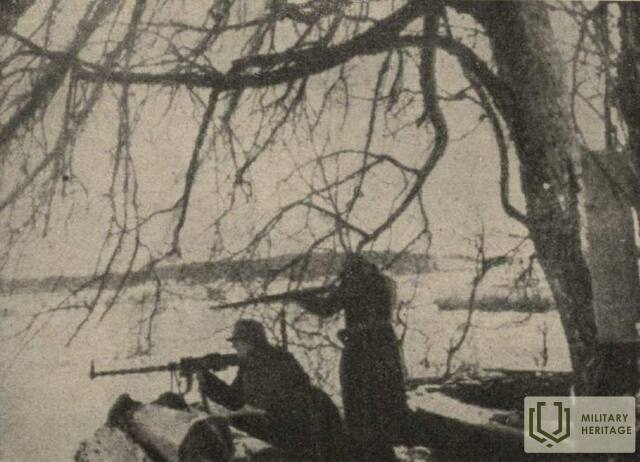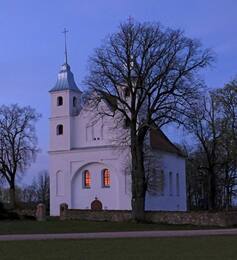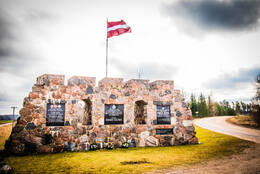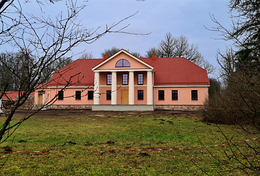Erinnerungen des Kapitäns Alexander Leving an die Erkundung der Venta bei Lena
Im Februar 1919 fanden auf beiden Seiten des Venta-Flusses Aufklärungsaktionen statt. Hauptmann Alexander Loeving, Chef der Kavalleriedivision, war einer der Befehlshaber der Aufklärungsangriffe.
Ein weiterer unvergesslicher Aufklärungsmarsch fand am 12. Februar statt. Am frühen Morgen ging es mit 8 Fahrern nach Slow. Wir ließen die Pferde bei der Wacheinheit zurück, gingen über die Venta zum anderen Ufer und begannen, uns unter dem Schutz einer Klippe nach Norden zu bewegen. Wir kamen an Pikuļi vorbei, das bekanntermaßen ein rotes Kabel hatte. Dann wenden wir uns an Birznieki. In der Nähe dieser Häuser gab es eine merkliche Bewegung und einige Karren waren sichtbar. Uzdevu ltn. (später Oberst) Gehen wir mit ein paar Reitern dorthin. Ich selbst und die anderen kehrten nach Venta an unser Ufer zurück und nahmen am Waldrand bei Kurmä Stellung, damit ich mich mit Feuer ernähren konnte. Lassen Sie die Gruppe fallen und decken Sie ihre Abreise ab. Unsere Späher bemerkten bald unsere Späher und wollten sie zurückgeben. Wir eröffneten das Feuer und sorgten für große Verwirrung beim Gegner. Nun, es war höchste Zeit für unsere Gruppe aufzubrechen. Ich hatte Angst, dass es nur nicht im Fluss landen würde, wenn ich schnell wegfahre, weil es an vielen Stellen keine Eisschichten gab. Devos ar vltn. Verzweigen Sie sich zurück über den Fluss und markieren Sie den Übergangspunkt mit Nadeln. Wir schlüpften dann durch die Küstenbüsche, um zu sehen, wo sich unsere Gruppe aufhielt. Das Feuer am Rande des Kurmu-Waldes war noch im Gange. Plötzlich sahen wir in etwa 100 Metern Entfernung nur noch einen roten Schwarm, der aus dem nahegelegenen Wald lief. Wir begannen so weit wie möglich zu schießen und standen aufrecht, um den Gegner auch moralisch zu beeinflussen. Der Zusammenstoß endete mit dem hastigen Rückzug der Bolschewiki aus Birznieki. Wir sind alle gesund und munter zurückgekehrt, beide in einem Schweiß. Wir gingen mit Liedern nach Lena, wo wir auf Pferden saßen, um mit einer Nachricht an den Oberst nach Rudbārži zu gehen.
Krīpēns A., Kalpaka-Bataillon und Balozs-Brigade, Belimora, 1963.
Zugehörige Zeitleiste
Zugehörige Objekte
Römisch-katholische Kirche der Heiligen Dreifaltigkeit in Lēni
Die Kirche befindet sich im Dorf Lēnu, Gemeinde Nīkrāce, Gemeinde Skrunda, an der Straße Skrunda - Embute.
In der Nähe der Kirche befindet sich der Fluss Venta, dessen Ufer im Februar 1919 von Soldaten des 1. lettischen Separatbataillons bewacht wurde. Da die Zahl der Soldaten des Bataillons eine durchgehende Frontlinie nicht zuließ, wurde die Front von Wachposten bewacht. Einer von ihnen befand sich auch am Ufer des Flusses in der Nähe der Kirche. Die Kirchtürme dienten der Überwachung der Umgebung und der anderen Seite des Flusses.
Gedenkstätte für das 1. lettische Separatistenbataillon in Lėnai und Verlegungsort auf der Venta
Das Denkmal befindet sich in Lēņi, an einer Straßenkreuzung in der Nähe des Herrenhauses von Lēņi.
Das Denkmal wurde am 8. November 2007 eingeweiht. Es wurde von der Bildhauerin Maija Engele entworfen. Der Autor und Finanzier des Denkmals ist Jānis Blūms, dessen Vater, Oberleutnant Paulis Blūms, 1. Leutnant der 1. lettischen Kavallerie-Division, die Flussüberquerung am 3. März 1919 mit Hilfe von 10 Männern organisierte und leitete.
Jedes Jahr am 3. März versammeln sich hier junge Gardisten, Soldaten und andere interessierte Personen zu einer Gedenkveranstaltung zu Ehren des 1. lettischen Separatbataillons.
Herrenhaus Lēnu
Das Schloss befindet sich im Dorf Lēnu, am Fluss Venta. Das Schloss befindet sich derzeit in Privatbesitz und ist daher nur aus der Ferne zu sehen.
Das Herrenhaus diente dem 1. lettischen Separatbataillon von Ende Januar bis zum 3. März 1919 als Stützpunkt. Das lettische Separatbataillon musste die Umgebung des Herrenhauses Leni befreien, um den Fluss gegenüber von Jaunmuiža überqueren zu können.
Das Gut gehörte dem Baron Friedrich von Firks, dem auch die Güter Rudbāržzi und Sieksate gehörten. Das Herrenhaus wurde im 19. Jahrhundert erbaut. Für den Baron diente das Schloss Lēnu vor allem als Ort der Jagd und der Wochenenderholung.
Von 1927 bis 1937 war das Schloss eine Schule, und während der sowjetischen Besatzung diente es als Holzwerkstatt der Kolchose. Im Jahr 1965 wurde ein Gemeindezentrum eröffnet. Das Gebäudeensemble hat zahlreiche Veränderungen erfahren, und der Park ist nicht erhalten geblieben. Einige Nebengebäude sind erhalten geblieben.








